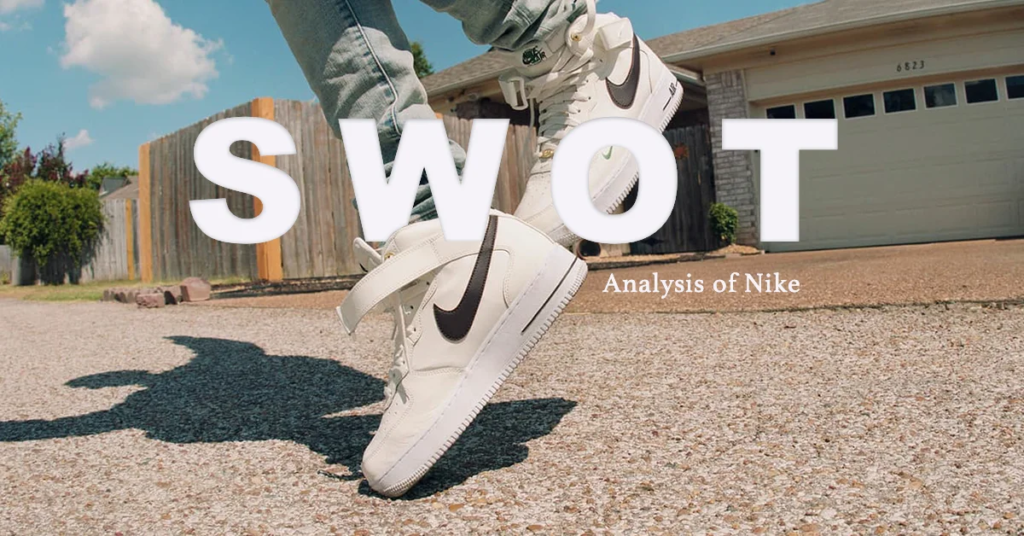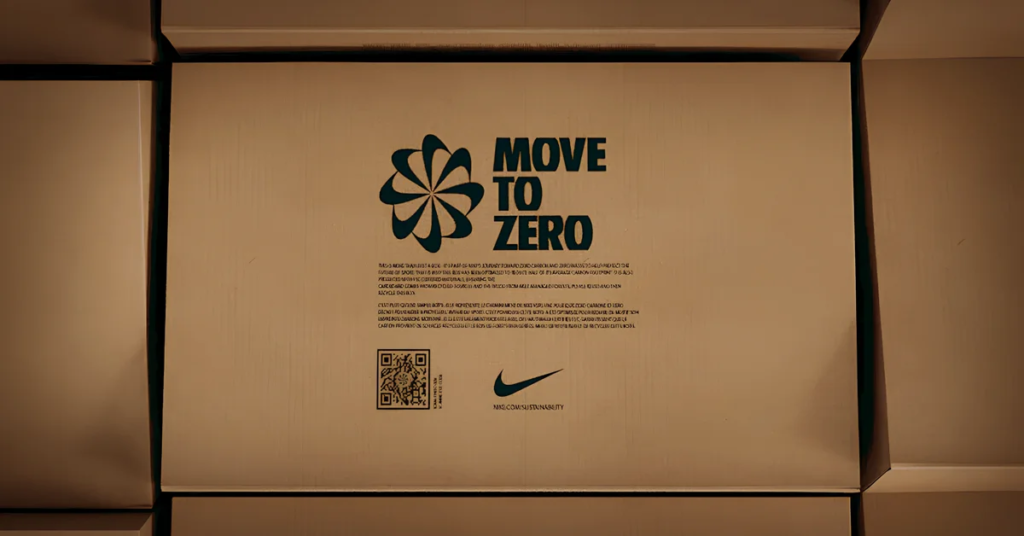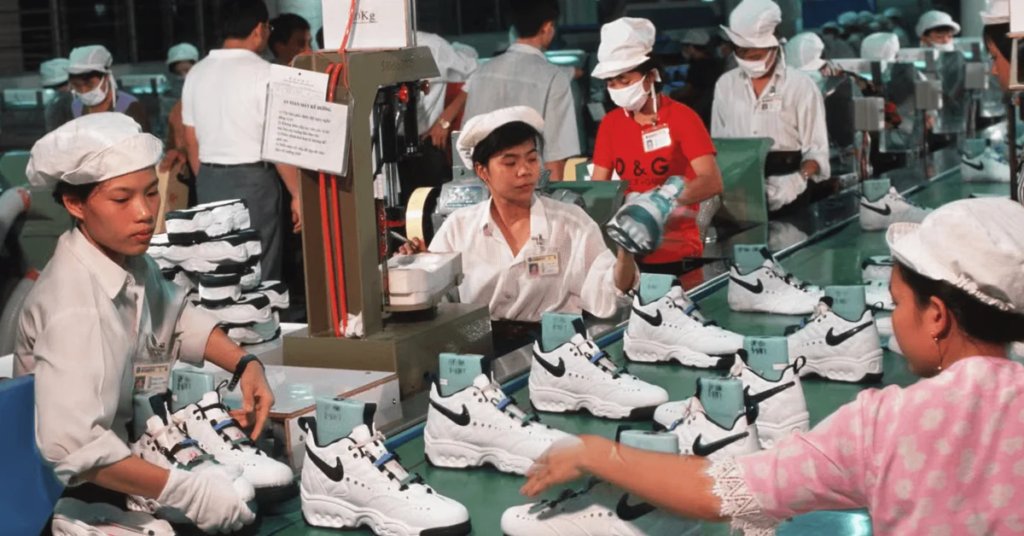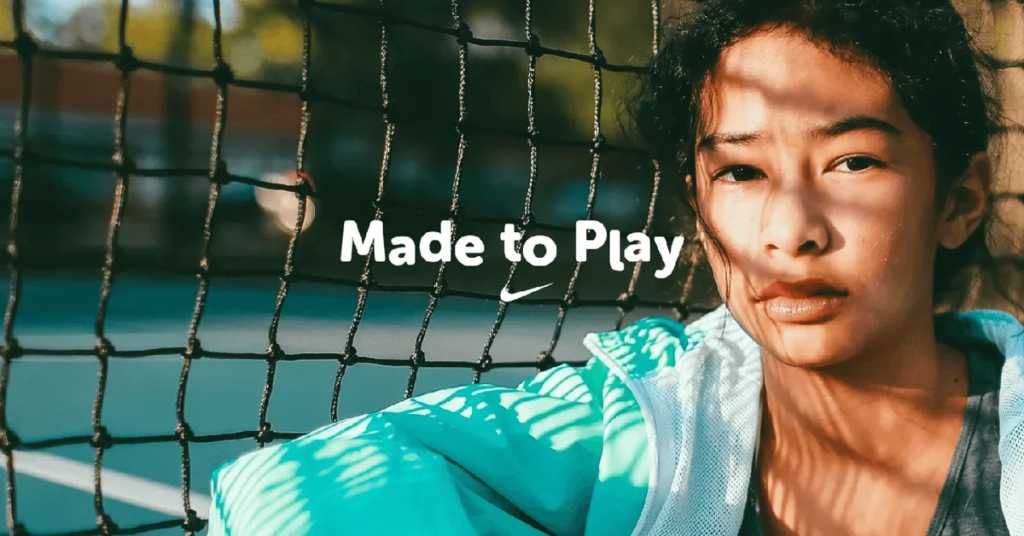Unleashing Nike's Power: A SWOT Analysis of Nike

Nike, a global powerhouse in athletic footwear, apparel, and sports equipment, is synonymous with innovation, excellence, and brand leadership. As one of the most most recognizable brands and trusted names in sportswear, Nike has successfully carved out a dominant position in a competitive global market. This SWOT analysis provides an in-depth evaluation of Nike’s strengths, weaknesses, opportunities, and threats. By identifying areas of success and potential risks, this analysis highlights how Nike can leverage its unique advantages to navigate challenges and secure future growth.
The analysis begins by highlighting Nike’s strengths, which include its strong brand awareness and value, extensive customer base, commitment to sustainability, and superior marketing capabilities. Nike’s iconic Swoosh logo and “Just Do It” tagline are universally recognized, providing the company with a competitive edge in a crowded global market. The brand’s focus on sustainability, through initiatives like the “Move to Zero” campaign, enhances its appeal to eco-conscious consumers. Additionally, Nike’s marketing prowess, backed by strategic endorsements with elite athletes, ensures its continued relevance and influence.
On the other hand, Nike faces several weaknesses, such as labor practices concerns, dependence on retailers, high debt levels, and market dependency. The company’s reliance on outsourced manufacturing exposes it to risks like supply chain disruptions and ethical issues. Moreover, its premium pricing strategy might alienate price-sensitive consumers, particularly in emerging markets. Addressing these weaknesses is crucial for Nike to maintain its market position and reputation.
The opportunities outlined in this analysis include expansion in emerging markets, a focus on the women’s market, sustainability initiatives, and innovation in wearable technology. By capitalizing on these opportunities, Nike can strengthen its market presence and drive growth. However, the company must also navigate threats such as counterfeit products, intense competition, economic uncertainty, and other supply chain issues and disruptions. Through strategic planning and innovation, Nike can overcome these challenges and continue to thrive as a global leader in the sportswear industry.
Strengths: Key Strengths That Power Nike's Success

Strong Brand Awareness and Value
Nike is recognized globally as the ninth most valuable brand, boasting a remarkable brand value of $53.7 billion. This prominent brand recognition affords Nike a significant competitive advantage in a densely populated market, helping it to maintain a loyal customer base and continually attract new consumers from various regions. The company’s iconic Swoosh logo and its motivational slogan, “Just Do It,” stand as universally the most recognizable brands and symbols of athletic prowess and encouragement.
This strong brand value is a testament to Nike’s capacity to stay ahead of its competitors through effective marketing strategies and distinctive product offerings. As evidenced by Interbrand’s Best Global Brands ranking, Nike consistently secures a spot among the top global brands, underscoring its vast influence and worth. Such prestigious recognition enables Nike to command premium pricing, further cementing its status as a leading player on the global stage.
Extensive Customer Base
In March 2024, Nike.com experienced over 124 million visits, demonstrating the brand’s substantial online presence and the trust it commands among consumers. Nike’s extensive customer base covers a broad spectrum of continents, demographics, and economic strata, providing a robust and continuous stream of revenue. This reach is further supported by Nike’s direct-to-consumer (DTC) strategy, which not only improves the customer experience but also significantly boosts sales.
Platforms like the Nike Training Club and Nike Run Club apps exemplify Nike’s commitment to community building, engaging millions of users worldwide. Nike’s emphasis on digital transformation has proven essential; its e-commerce platforms offer personalized experiences that play a crucial role in maintaining customer loyalty and encouraging repeat business.
Commitment to Sustainability
Nike has strategically integrated sustainability into its core business operations, placing a high priority on environmental issues without compromising on product innovation. The brand’s “Move to Zero” initiative exemplifies this commitment, with ambitious goals to eliminate carbon emissions and waste throughout its operations. Innovations such as Flyknit and recycled polyester play a crucial role in this strategy, significantly minimizing material waste while maintaining high performance standards. For example, Flyknit technology has slashed waste by 60% when compared to traditional shoe manufacturing processes.
Additionally, Nike’s Solar Array project showcases its proactive approach to combating climate change, with factories running on renewable energy sources. This focus on sustainability not only appeals to environmentally conscious consumers but also strengthens Nike’s brand reputation and supports its long-term growth objectives.
Superior Marketing Capabilities
Nike’s marketing strategy is celebrated for its emotive and aspirational impact. The company allocates billions each year to sponsorships, advertisements, and celebrity endorsements, securing its dominance in the sportswear and apparel industry. Its partnerships with legendary athletes like LeBron James, Serena Williams, and Cristiano Ronaldo amplify its synonymous relationship with supreme athletic achievement. Moreover, impactful campaigns such as “Dream Crazy,” which featured Colin Kaepernick, have spurred extensive engagement, positioning Nike at the heart of cultural movements and championing inclusivity.
Additionally, Nike’s savvy engagement with social media platforms significantly boosts its interaction with customers. For instance, Nike’s Instagram account has attracted over 300 million followers, underscoring its pervasive presence online. This strategic approach to marketing ensures Nike continually captures and retains consumer attention, maintaining its prominent position in the market.
Nike’s dedication to social and cultural movements strongly resonates with today’s consumers, aligning with their values and garnering support. By championing causes such as racial equality, gender equity, and youth empowerment, Nike forges meaningful connections with socially conscious audiences. Notably, in response to the global Black Lives Matter movement, Nike committed $40 million to various organizations supporting the Black community. Additionally, the company promotes gender equality with initiatives like the “Made to Play” program, designed to encourage girls to engage in sports.
These concerted efforts not only enhance Nike’s corporate social responsibility (CSR) profile but also build deeper emotional connections with consumers. Through these actions, Nike demonstrates a commitment to societal progress, strengthening its brand and deepening its consumer relationships.
High Market Share
As of 2023, Nike holds a commanding position in the global athletic footwear and sportswear markets, with a market share of approximately 27.4%. This dominance stems from relentless product innovation, strategic acquisitions, and robust marketing campaigns. Nike’s sports footwear segment, in particular, leads the global market, surpassing major competitors such as Adidas and Puma. Additionally, its expanding influence in emerging markets, especially in the Asia-Pacific region, contributes significantly to its growth and helps cement its market position.
This consistent performance across its major segments places Nike in an advantageous position to maintain and further enhance its leadership within the sports apparel and footwear industry. With these strategic moves, Nike is not only defending its existing market share but is also set to expand its influence globally.
Side Brands
Sub-brands such as Converse and Hurley play crucial roles in Nike’s diversified business strategy. Converse, acquired in 2003, continues to maintain its cultural relevance with iconic products like the Chuck Taylor All-Stars, which resonate strongly with younger, fashion-conscious consumers. Similarly, luxury brand Hurley, with its focus on surf apparel and athletic footwear, extends Nike’s reach into niche markets, broadening the company’s appeal and customer base.
These sub-brands significantly diversify Nike’s revenue streams and help mitigate risks associated with overreliance on the core Nike brand. By integrating these distinct but complementary brands into its portfolio, Nike enhances its market stability and ensures sustained growth across various consumer segments.
Low Manufacturing Costs
Nike’s production model capitalizes on strategic outsourcing to countries such as Vietnam, Indonesia, and China, where low-cost labor and well-developed manufacturing infrastructures are plentiful. This approach enables Nike to sustain high profitability levels by minimizing production costs. The company employs a contract manufacturing model, which facilitates rapid scaling of production with minimal capital expenditure, ensuring that Nike can remain agile in response to market demands.
This strategic production setup allows Nike to maintain competitive pricing while achieving high profit margins, even as it continues to offer premium products. By leveraging global manufacturing efficiencies, Nike adeptly balances cost management with quality, reinforcing its position in the competitive sportswear market.
Top-Tier In-House Talent
Nike employs a workforce comprised of some of the industry’s most talented professionals in design, marketing, and research and development. The company places a strong emphasis on talent acquisition and training, dedicating substantial resources to these areas to spur innovation. This investment enables designers and engineers to collaborate effectively, leading to the creation of groundbreaking products such as the Nike Air Zoom and Vaporfly series, which have significantly advanced the field of athletic footwear.
The culture of innovation at Nike is deeply rooted in its commitment to employee development and collaboration. By fostering an environment where ideas can flourish and where team members are encouraged to push the boundaries of what’s possible, Nike ensures it remains at the forefront of product innovation and industry leadership.
Diverse Brand Portfolio
Nike’s product lineup spans various categories, including footwear, apparel, equipment, and accessories. Iconic product lines such as Nike Air Max, Shox, Tiempo, and Pegasus cater to different consumer needs, ensuring broad market appeal. Additionally, Nike’s ability to integrate style, comfort, and performance has led to widespread adoption in both athletic and lifestyle markets.
Innovation
Nike’s leadership in research and development drives product breakthroughs that push the boundaries of athletic performance. Technologies like Flyknit, ZoomX foam, and Dri-FIT have revolutionised footwear and apparel. The Nike Adapt series, which features self-lacing shoes, showcases the company’s cutting-edge innovation. Through constant R&D investments, Nike continues to lead in product design and functionality.
High Product Quality
Nike is renowned for the high quality of its products, which are designed to deliver durability, comfort, and performance. This commitment to excellence serves both professional athletes and everyday consumers, ensuring that all users experience superior product quality that meets their specific needs. For instance, Nike’s React foam technology provides exceptional cushioning, greatly enhancing comfort for runners and fitness enthusiasts, making it a standout choice for those seeking both support and performance.
This unwavering dedication to maintaining high standards across its product range plays a pivotal role in strengthening brand loyalty among customers. Nike’s focus on quality not only satisfies immediate consumer needs but also reinforces the trust and reliability associated with the Nike brand, further solidifying its market position.
Exceptional Brand Loyalty
Nike has successfully cultivated exceptional brand loyalty through a consistent commitment to delivering innovative products and engaging marketing campaigns. The company’s loyalty programs, like NikePlus, play a crucial role in this strategy by rewarding members with exclusive offers and opportunities, further deepening the relationship between the brand and its customers. This approach not only retains existing customers but also transforms them into brand advocates.
These long-standing customers are invaluable as they drive word-of-mouth marketing, sharing their positive experiences and promoting Nike’s products organically. This grassroots promotion is instrumental in expanding Nike’s reach and influence, reinforcing the strong loyalty that customers feel towards the brand.
Strategic Endorsements
Nike’s strategic use of endorsements with elite athletes significantly amplifies its credibility and broadens its appeal. Iconic partnerships, such as the one with Michael Jordan through the Air Jordan brand, have not only been lucrative, contributing billions to Nike’s revenue over the years, but have also enriched the brand’s aspirational value. These collaborations resonate deeply with consumers, who see these athletes not just as endorsers, but as integral parts of the brand’s identity and legacy.
This aspirational connection fosters strong consumer loyalty and positions Nike as more than just a product manufacturer; it becomes a key player in the cultural and professional landscapes of sports. Such strategic partnerships and endorsements ensure that Nike remains relevant and admired in the competitive sportswear market, driving sustained consumer interest and long-term loyalty.
Global Distribution Network
Nike’s global distribution network is vast, encompassing over 190 countries through a combination of retail stores, e-commerce platforms, and partner retail outlets. This extensive reach ensures that Nike products are readily accessible worldwide, reinforcing the brand’s market dominance.
By strategically placing its products in both physical and digital sales channels, Nike caters to a diverse global audience, enhancing customer convenience and driving sales across different regions. This robust network not only supports Nike’s market presence but also plays a critical role in its ongoing global expansion.
Digital Transformation
Nike has fully embraced digital transformation to elevate customer engagement and boost sales. The company’s strategic investments in e-commerce, mobile applications, and wearable technologies have positioned it as a front-runner in adopting digital advancements. Notable examples include the SNKRS app, which offers a unique and immersive shopping experience tailored to sneaker enthusiasts, and the Nike Fit app, which employs artificial intelligence to recommend the most accurate shoe sizes to customers, enhancing user satisfaction and reducing returns.
By leveraging these digital capabilities, Nike not only enhances the consumer shopping experience but also secures its position as a dominant force in the global sportswear market. These initiatives are integral to Nike’s strategy of driving continuous innovation and growth, ensuring it remains at the forefront of both technology and fashion in the sportswear industry.
Weaknesses: Challenges Nike Can Overcome

Labour Practices and Ethical Concerns
Nike has encountered significant criticism over its labor practices in developing countries, with reports detailing low wages, unsafe working conditions, and allegations of child labor causing widespread consternation. Manufacturing facilities in key hubs such as Vietnam, China, and Indonesia have frequently been implicated in labor rights violations. These issues have not only sparked global protests and boycotts but have also tarnished Nike’s brand reputation.
Despite efforts to enhance transparency and improve labor conditions, ethical concerns continue to pose a substantial challenge for Nike. Today’s consumers are more socially aware than ever before, and persistent negative views of Nike’s supply chain practices could deter this increasingly conscientious demographic. This shift in consumer awareness underscores the importance of sustained improvements in Nike’s ethical practices to maintain its market position.
Dependence on Retailers
Despite Nike’s shift toward direct-to-consumer (DTC) sales, third-party retailers and wholesalers still play a crucial role in its distribution, representing about 65% of its total sales. This reliance grants significant bargaining power to large retailers, potentially limiting Nike’s control over pricing, product presentation, and overall brand experience.
Conflicts with key retailers or shifts in their strategies, such as favoring competitor brands, could adversely affect Nike’s market share and profitability. Moving towards a greater focus on DTC sales might necessitate hefty investments in both infrastructure and technology to mitigate these risks and enhance control over its market dynamics.
High Debt Levels
As of February FY24, Nike reported long-term debt amounting to $8.9 billion. Despite its robust revenue streams, this substantial debt poses a financial risk, particularly in times of economic downturns or unexpected disruptions.
The potential for rising interest rates could escalate the costs associated with servicing this debt, thereby constraining Nike’s financial flexibility. This scenario could limit the company’s capacity to invest in areas like innovation, expansion, and sustainability initiatives, crucial for its long-term growth.
U.S. Market Dependency
Nike derives over 40% of its revenue from the United States, indicating a significant dependence on this single market. Such concentration exposes the company to substantial risks; economic downturns, regulatory changes, or shifts in consumer behavior within the U.S. could greatly affect Nike’s overall performance.
Additionally, if competitors strengthen their foothold in the U.S. market, it could further threaten Nike’s dominant position. This vulnerability underscores the need for Nike to diversify its market presence and reduce reliance on American consumers to stabilize its business against potential local disruptions.
Outsourced Manufacturing Risks
Nike’s extensive use of outsourced manufacturing introduces various risks, including quality control issues, supply chain disruptions, labor concerns, and geopolitical tensions. The concentration of its production facilities in a limited number of countries further heightens Nike’s susceptibility to interruptions stemming from natural disasters, labor strikes, or geopolitical conflicts.
The COVID-19 pandemic highlighted these vulnerabilities, as it disrupted global supply chains, leading to significant delays in production and distribution for Nike. Such exposure underscores the need for the company to enhance its supply chain resilience and diversify its manufacturing base to mitigate future risks.
Premium Pricing Strategy
Nike’s premium pricing strategy positions its products at a higher cost, which may deter price-sensitive consumers, especially in emerging markets. This approach risks alienating a significant segment of potential customers who might turn to competitors like Adidas and Puma, which offer similar quality items at more accessible price points.
Moreover, economic instability or a decrease in consumer purchasing power could intensify this issue, further threatening Nike’s market share. To counter these challenges, Nike may need to consider adjusting its pricing strategy or enhancing the perceived value of its products to maintain competitiveness and appeal to a broader audience.
Reputation Risk
Nike’s global reputation stands as one of its most significant assets, yet it also presents a potential vulnerability. Controversies surrounding labor practices, environmental policies, or cultural missteps can quickly lead to backlash and diminish consumer trust. For instance, while campaigns like “Dream Crazy” have received acclaim, they have also faced criticism, highlighting the fine line Nike must walk in engaging with social issues.
This delicate balance is crucial for maintaining brand integrity and customer loyalty. Missteps in these areas can alienate customers, necessitating a thoughtful and well-calibrated approach to how Nike handles sensitive and potentially divisive topics.
Counterfeit Products
The proliferation of counterfeit Nike products, especially in regions like Asia, poses a significant challenge for the brand. These fake goods not only cut into Nike’s revenue but also compromise its brand integrity, as consumers often associate the inferior quality and performance of counterfeits with Nike’s genuine products.
To combat this issue, Nike must invest heavily in anti-counterfeiting technologies and legal measures to enforce its intellectual property rights. Such efforts are essential to maintain the brand’s reputation for quality and performance and to protect its market share from the damaging effects of counterfeit operations.
Limited Product Diversification
Nike’s focus on athletic footwear and apparel, while successful, also makes the brand vulnerable to downturns specific to the industry or shifts in consumer preferences. This overreliance on a limited range of products could pose risks if market dynamics change or consumer interests evolve.
To mitigate these risks, Nike could benefit from diversifying into adjacent markets such as wearable technology or athleisure. However, entering these new segments would necessitate significant investments in research and development (R&D) and marketing. Such strategic expansion could help stabilize Nike’s revenue streams and broaden its market appeal, ensuring resilience against fluctuations in the athletic wear market.
Supply Chain Vulnerabilities
Nike’s centralized production model, although cost-effective, exposes the company to significant risks of disruption. Factors such as raw material shortages, trade restrictions, or environmental challenges can delay production, resulting in inventory shortages that disrupt nike’s sales and operations.
To address these vulnerabilities, it is critical for Nike to develop a more distributed and resilient supply chain. By diversifying production locations and sourcing strategies, Nike can better withstand disruptions and maintain steady supply flows. This strategic adjustment is essential for sustaining production efficiency and ensuring the brand’s ability to meet global demand consistently.
Rising Labour and Material Costs
Inflation, along with rising costs for raw materials, labor, and logistics, presents ongoing challenges for Nike. These increased production costs threaten to erode profit margins or compel the company to raise product prices, which could alienate budget-conscious consumers.
To navigate these financial pressures, Nike may need to explore strategic measures such as optimizing supply chain efficiency, renegotiating supplier contracts, or adopting more cost-effective production techniques. These actions can help manage costs and maintain competitiveness without sacrificing quality or significantly increasing prices for consumers.
Opportunities: Strategic Opportunities to Propel Nike Forward

Expansion in Emerging Markets
Emerging markets like India, Brazil, and China offer substantial growth opportunities for Nike, driven by a burgeoning middle class with rising disposable income and a growing enthusiasm for fitness and sports. To capitalize on these opportunities, Nike can expand its retail footprint, set up local manufacturing facilities, and introduce product lines that are both affordable and tailored to local preferences.
Moreover, investing in community engagement efforts such as grassroots sports programs can significantly enhance Nike’s brand perception and foster loyalty among new customer segments in these regions. By integrating into the local culture and supporting community interests, Nike can build a strong, trustworthy presence in these promising new markets too.
Focus on Women’s Market
The women’s athletic wear and sportswear market is expanding rapidly, fueled by an increase in female participation in sports and fitness worldwide. Nike is well-positioned to capitalize on this trend by customizing its products, marketing strategies, and customer experiences to better serve women athletes. Initiatives like the “Made to Play” program, alongside endorsements from renowned female athletes, highlight Nike’s commitment to empowering women.
Such targeted efforts not only demonstrate Nike’s support for women’s sports but also position the brand to capture a larger share of this quickly growing market segment. By focusing on the specific needs and aspirations of women athletes, Nike can enhance its brand relevance and appeal within this demographic, driving both engagement and sales.
Sustainability and Eco-Friendly Products
The rising consumer demand for sustainable and ethically produced goods offers Nike a significant opportunity to enhance its market position. By expanding its “Move to Zero” initiative and increasing the use of sustainable materials such as Flyleather and recycled polyester, Nike can meet the preferences of eco-conscious consumers. These efforts not only cater to customer values but also align with tightening global regulatory standards on environmental practices.
Investing in sustainability provides Nike with a competitive edge in the eco-friendly marketplace, appealing to a segment that values corporate responsibility. By focusing on green products, Nike not only adheres to ethical standards but also positions itself as a leader in sustainable practices in the sportswear industry, potentially attracting a broader customer base.
Innovation in Wearable Technology
The burgeoning field of wearable technology presents Nike with an exciting opportunity to diversify and innovate within its product lines. By integrating smart apparel and fitness devices into athletic shoes, Nike can enhance its offerings and deepen customer engagement. Collaborations with technology companies or increased investments in research and development could lead to innovative products such as connected shoes, fitness trackers, and performance-monitoring apparel.
These technological advancements not only bolster Nike’s role as a leader in sports innovation but also improve the user experience by providing valuable data and interactive features. Embracing wearable technology positions Nike at the forefront of the intersection between sports and tech, catering to a tech-savvy consumer base and expanding its market reach.
Digital Expansion and Direct-to-Consumer (DTC) Strategy
Nike’s strategic emphasis on e-commerce and its direct-to-consumer (DTC) model has been a key driver of growth. Further investment in digital platforms like the SNKRS app and Nike Fit can significantly enhance the customer experience by offering more personalization, convenience, and access to exclusive products. Such enhancements not only improve user engagement but also increase customer loyalty and satisfaction.
By expanding its DTC approach, Nike can reduce its dependence on third-party retailers, which in turn can lead to higher profit margins and stronger control over its brand. This shift not only streamlines operations but also allows Nike to directly influence its market image and consumer interactions, ensuring a more consistent and impactful brand experience.
Collaborations and Limited-Edition Releases
Nike has seen significant success with its collaborations involving designers, celebrities, and influencers, which have boosted the brand’s visibility and driven sales. Limited-edition releases, like the Air Jordan x Travis Scott collection, stir excitement and create a sense of scarcity, enhancing consumer demand. These collaborations not only capitalize on the fame of their partners but also introduce Nike’s products to new audiences, rejuvenating its image and appeal.
Expanding these collaborative efforts into emerging markets or branching into new product categories can further attract fashion-conscious and younger consumers. By tapping into these demographics, Nike can continue to innovate its brand positioning and product offerings, ensuring continued relevance and growth in a competitive marketplace.
Subscription Services
Subscription services like the Nike Adventure Club, which provides children’s shoes, showcase a promising avenue for stable, recurring revenue. Implementing subscription-based models for footwear, apparel, and even training programs could significantly deepen customer engagement and loyalty. Such models offer continuous interaction and personalized experiences that strengthen long-term customer relationships.
By expanding into subscription services, Nike can not only enhance its brand loyalty but also stabilize its revenue streams. This approach ensures a consistent customer base and provides predictable income, which is beneficial for long-term business planning and growth in the highly competitive sportswear market.
Growth of Athleisure Market
The athleisure apparel market, characterized by stylish, comfortable activewear suitable for everyday use, continues to expand globally. This trend presents an excellent opportunity for Nike to capitalize on by diversifying its product offerings to include lines that seamlessly blend functionality with fashion. By doing so, Nike can attract lifestyle-conscious consumers who may not necessarily be athletes or fitness enthusiasts but are looking for versatile clothing that suits their active, casual lifestyles.
Expanding into this segment allows Nike to broaden its consumer base and appeal to a wider audience, including those seeking style as much as performance. This strategic move can position Nike not just as a sports brand but as a lifestyle brand, thus capturing a significant share of this growing market.
Localised Production
nvesting in localized manufacturing offers Nike multiple strategic advantages. By producing goods closer to key markets, Nike can reduce supply chain vulnerabilities, decrease production costs, and enhance its ability to respond swiftly to shifting market demands. This approach not only streamlines operations but also improves the efficiency of inventory management and distribution.
Furthermore, localized production aligns with sustainability objectives by significantly reducing transportation-related carbon emissions. This commitment to reducing its environmental footprint can strengthen Nike’s brand image among increasingly eco-conscious consumers, while also contributing to global sustainability efforts.
Expansion of Sports Experiences
Nike can enhance customer engagement by expanding its sports experiences through events, academies, and training programs. Hosting global and local athletic events strengthens brand visibility while fostering deeper connections with sports enthusiasts and professional athletes. These initiatives position Nike as more than just a retailer, but as an active participant in the sports community.
By investing in training experiences and academies, Nike can further solidify its role in athlete development while driving long-term brand loyalty. These programs not only enhance consumer interaction but also create immersive brand experiences, reinforcing Nike’s commitment to performance, innovation, and community building.
Threats: Navigating Challenges to Secure Nike's Future

Counterfeit Products
The widespread presence of counterfeit Nike products, especially in regions like Asia, poses a notable threat to the brand. These counterfeit items not only diminish Nike’s revenue but also tarnish its brand reputation by failing to meet the quality and performance standards that consumers expect from genuine Nike products.
Counterfeit goods undermine consumer trust and can lead to negative perceptions of the Nike brand, as customers who unknowingly purchase fake items may associate their subpar quality with Nike itself. To combat this issue, Nike must invest in robust anti-counterfeiting measures and legal actions to protect its brand
Intense Competition
Nike’s footwear also faces fierce competition from major global brands like Adidas, Puma, and Under Armour, as well as emerging local players. These competitors are not only investing heavily in innovative product development and strategic collaborations but are also focusing on sustainable practices. This intensifies the battle for market share, pushing Nike to continuously innovate and differentiate its offerings to maintain its competitive edge.
To stay ahead, Nike must leverage its superior marketing capabilities and strong brand value while also addressing the evolving demands of eco-conscious consumers. By staying attuned to market trends and consumer preferences, Nike can navigate this highly competitive landscape effectively, ensuring its continued prominence in the global sportswear industry.
Economic Uncertainty
Economic challenges such as global downturns, inflation, and recessions significantly impact consumer spending, particularly on premium products. When key markets like the U.S. and Europe face economic hardships, Nike’s profitability can be directly affected. Consumers tend to prioritize essential purchases during tough economic times, which can lead to a decline in demand for Nike’s higher-priced offerings. This shift in spending behavior underscores the importance for Nike to adapt its strategies to maintain its market position and financial health.
In response to these economic uncertainties, Nike must continuously innovate and offer value-driven products that appeal to cost-conscious consumers. By focusing on affordability without compromising quality, Nike can mitigate potential revenue losses during economic downturns. Additionally, diversifying its market presence beyond traditional strongholds can provide a buffer against regional economic fluctuations. These proactive measures will help Nike navigate the challenges posed by economic instability
Supply Chain Disruptions
Geopolitical tensions, pandemics, and natural disasters present considerable challenges to Nike’s outsourced manufacturing model. These internal and external factors can lead to significant delays in production or shipping, which in turn disrupt supply chains. Such disruptions often result in inventory shortages, ultimately impacting Nike’s revenue and operational efficiency.
To mitigate these risks, it is essential for Nike to develop a more resilient supply chain strategy. By diversifying manufacturing locations and enhancing contingency plans, Nike can better withstand unexpected disruptions. This proactive approach will help ensure steady production flows and maintain the company’s ability to meet global consumer demand effectively.
Regulatory Challenges
Navigating the complexities of changing international trade policies, tariffs, and labor laws, particularly in manufacturing hubs like China and Vietnam, presents significant challenges for Nike. These regulatory shifts add layers of operational complexity and have the potential to increase costs, impacting the company’s overall efficiency and profitability. As these regions are central to Nike’s manufacturing operations, any changes in trade agreements or labor legislation can have far-reaching implications for the brand’s supply chain and cost structure.
To effectively manage these challenges, Nike must remain agile and proactive in its approach to regulatory compliance. This involves continuously monitoring global trade developments and adapting strategies to mitigate potential disruptions. By fostering strong relationships with local governments and ensuring adherence to evolving labor standards, Nike can navigate these complexities more smoothly, safeguarding its operations and maintaining its competitive edge in the global sportswear market.
Currency Fluctuations
As a global brand, Nike is susceptible to the fluctuations of foreign exchange rates, which can significantly impact its profits from international markets. These currency variations can affect the company’s financial performance by altering the value of revenue earned abroad when converted back to its home currency.
To mitigate these risks, Nike must employ strategic financial management practices, such as hedging, to protect its earnings from adverse currency movements. By doing so, Nike can stabilize its financial outcomes and maintain profitability, ensuring its continued success in the competitive global sportswear industry.
Climate Change
Nike faces the significant challenge of environmental factors, such as extreme weather events, which can severely disrupt its production facilities and the supply of raw materials. These disruptions not only hinder operational efficiency but also increase costs, posing a threat to Nike’s overall business performance. As climate change continues to escalate, the frequency and intensity of these events are likely to rise, further complicating the company’s supply chain and production processes.
To mitigate these risks, Nike must invest in adaptive strategies and resilient infrastructure that can withstand environmental impacts. By diversifying its supply chain and incorporating sustainable practices into its operations, Nike can better manage the uncertainties posed by climate change. These proactive measures are essential for maintaining operational stability and ensuring that Nike remains a leader in the global sportswear industry despite environmental challenges.
Data Breaches
As Nike continues to expand its digital platforms, it faces an increased risk of cyberattacks. These data breaches can significantly undermine customer trust, leading to potential financial losses and damaging Nike’s reputation. The growing reliance on digital technology makes it imperative for Nike to prioritize cybersecurity measures to protect sensitive information and maintain consumer confidence.
To mitigate these risks, Nike must invest in robust cybersecurity infrastructure and implement proactive strategies to safeguard its digital assets. By doing so, the company can not only protect its brand integrity but also ensure a secure and seamless experience for its customers, reinforcing trust and loyalty in an increasingly digital marketplace.
Changing Consumer Preferences
In today’s fast-paced world, Nike must stay ahead of rapidly evolving fashion trends, athletic needs, and sustainability demands. The company is tasked with continuously innovating to remain relevant in the ever-changing market landscape. Failing to anticipate and adapt to these shifts could significantly diminish its market standing.
To maintain its competitive edge, Nike must proactively engage in research and development, ensuring that its products align with current consumer preferences and environmental expectations. By staying attuned to these dynamic changes, Nike can sustain its position as a leader in the sportswear industry, meeting the needs of its diverse
Dependence on Endorsers
Nike’s reliance on celebrity endorsements serves as both a powerful marketing tool and a potential risk. While partnerships with high-profile athletes can significantly enhance brand appeal and credibility, any scandals or controversies involving these figures can adversely affect Nike’s brand image and lead to consumer alienation.
Such incidents can tarnish the public perception of Nike and diminish the effectiveness of these endorsements. To mitigate this risk, Nike must carefully select endorsers who align with its brand values and maintain a strong public relations strategy to manage any potential fallout from unforeseen controversies.
Rising Labour and Production Costs
Rising wages, increasing raw material costs, and higher shipping expenses are putting pressure on Nike’s production costs, ultimately squeezing profit margins. These escalating expenses challenge Nike’s ability to maintain competitive pricing while ensuring profitability, necessitating strategic adjustments to cost management practices.
To navigate these financial pressures, Nike must explore innovative solutions such as optimizing its supply chain efficiency and renegotiating supplier contracts. By adopting more cost-effective production techniques, Nike can better manage these rising costs, ensuring it continues to deliver high-quality products without significantly increasing prices for consumers.
Legal and Litigation Risks
Nike is currently embroiled in various legal challenges concerning labor practices, patent disputes, and compliance with environmental regulations. These legal battles not only pose financial burdens but also threaten to tarnish the credibility of the Nike brand and the company as a whole. The costs associated with such litigation can be substantial, potentially affecting Nike’s financial health and public image.
To counter these threats, Nike must engage in strategic planning, foster innovation, and implement effective risk mitigation strategies. By proactively addressing these legal and reputational challenges, Nike can safeguard its position as a leader in the global sportswear industry. Through careful management and forward-thinking approaches, Nike is poised to maintain its competitive edge and continue thriving in a highly dynamic market.
Summary

Nike’s SWOT analysis underscores its formidable strengths, including its globally recognized brand, exceptional marketing capabilities, and steadfast commitment to sustainability. Despite facing challenges such as ethical labor concerns, high debt levels, and market dependence, Nike’s capacity for innovation and its robust digital transformation strategy ensure its resilience in the competitive landscape.
The opportunities for Nike are abundant, particularly in emerging markets, women’s athletic wear, wearable technology, and sustainable products, all of which can drive future growth. Nonetheless, the company must contend with threats like intense competition, counterfeit products, and supply chain disruptions, necessitating strategic planning and innovation. By capitalizing on its strengths and addressing its weaknesses, Nike is well-equipped to overcome these challenges and maintain its leadership in the global sportswear industry.




